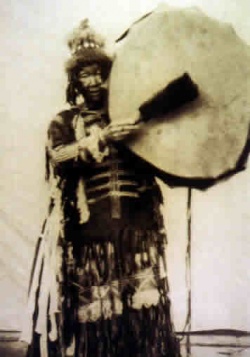Yoginī tantra
Yogini Tantra is a 16th-century tantric text by an unknown author from Assam, India and dedicated to the worship of Hindu goddesses Kali and Kamakhya. Apart from religious and philosophical themes, this voluminous tantra contains some historical information.
The text is especially important for the vamachara form of tantric worship.
Like many other Kaula-inspired texts, Yogini-Tantra advocates the moral codes of mainstream Hinduism to be broken and suspends many of the usual prohibitions concerning inter-marriage between members of different castes. It allows women to speak up to everyone and to have intimate relationships with whom they please.
Date and Place
The Yogini Tantra was written in Assam in the 16th-century. The date is determined from the reference to the 16th-century Koch dynasty (kuvacha) who are said to have been born to a Mech woman. Some authors place in the 17th-century.
Kiss of the Yoginī: "Tantric Sex" in its South Asian Contexts. By David Gordon White.
David Gordon White has established himself as one of the foremost authorities on the practices of yoga and tantra in South Asia, and his most recent work, Kiss of the Yoginī: "Tantric Sex" in its South Asian Contexts, only further solidifies his stature in the field.
It might be argued more broadly that White's scholarship on yoga and tantra in this work and in his previous work The Alchemical Body: Siddha Traditions in Medieval India demonstrates the continuing viability and utility of the History of Religions approach to the study of religion in South Asia.
Kiss of the Yoginī is a treasure trove of historical, textual, and interpretive arguments that is dizzying in its depth and scope.
The compelling central argument of the text—that tantric sexuality in its origins is a complex ritual system of exchange of "power substances" (sexual fluids) and is quite distinct from more recent Hindu modernist, Orientalist, and New Age appropriations—is only one among a number of groundbreaking insights into the nature of tantrism offered in the work.
It serves well what White perceives as an overarching goal of his academic work, demonstrating how tantra is a dominant, but often misrepresented, cultural force in the formation of Hindu religious practice and identity.
He supports this assertion through incisive historical study and a brilliantly systematic examination of key textual traditions within the scope of tantra in a manner that might be favorably compared to the use of thick description in anthropology, while simultaneously negotiating the often murky waters of postcolonial thought.
The foundation of White's argument is the assertion that prior to nineteenth- and twentieth-century modernist movements in Hinduism, the predominant foundation for popular Hinduism was ritualism (tantra), as opposed to devotionalism (bhakti), which has become the hallmark of Hindu modernism (Brāhman ical traditions focused on the worship of male divinities).
White argues that "postreformation" mainstream Hindu exponents are "possessed of . . . selective amnesia concerning both their own past and the multiplicity of practices that currently surround them" (7), echoing in some respects Agehananda Bharati's earlier assertions that Hindu modernism is "puritanical" in nature, disavowing its own not-so puritanical past.
Important as well in White's argument is the notion that tantric ritualism itself has been interpreted in a number of divergent ways, both within and outside of Indian tradition.
Of particular import throughout the work is the argument that the metaphorical interpretation of tantric actions of a transgressive nature obscures the original intentions of their formulators.
In this respect, White argues, analogies can be drawn between the high-caste "repackaging" of tantric ritualism in Abhinavagupta and the manner in which proponents of New Age tantra in Europe and America have appropriated its nomenclature and advertised it to a wealthy clientele (xii).
The basic logic of Kaula tantric sexuality, in contrast, is the "feeding" of hungry clan (kula) deities, notably a class of fearsome female goddesses termed "Yoginīs," sexual fluids in exchange for worldly powers (siddhi), bodily immortality (jīvanmukti), and enjoyment of those conditions (bhukti) (10).
A key point that is made by White in this respect is the fact that the attainment of power and bodily perfection is not necessarily conjoined with ideas of liberation from worldly existence (sam sāra).
Instead, White rightly places the emphasis on what I would refer to as the "numinous" power acquired through the ritual process, a "deification" that is exemplified by obtaining the power of yogic flight (khecara) (199–201).
The processes and practices underlying this exchange are made thoroughly evident by White in chapters dealing with the origins of the Yoginī cult, the Indian roots of "power substances," the logic of the use of the yantra and mandala (symbolic abodes of deities), and the influence and authority of tantric agents within Indian and Nepalese society.
White's examination of the morphology of Yoginī mythology is an excellent counterpart and extension to Vidya Dehejia's earlier study, Yoginī Cult and Temples, connecting...
Source
https://muse.jhu.edu/journals/aar/summary/v074/74.2sarbacker.html


